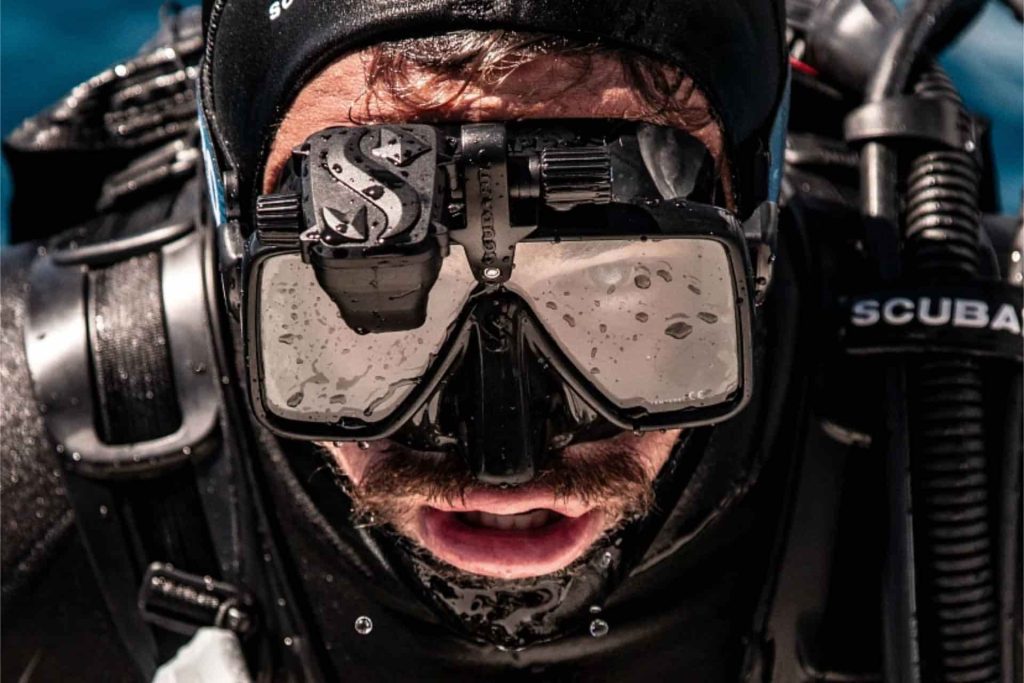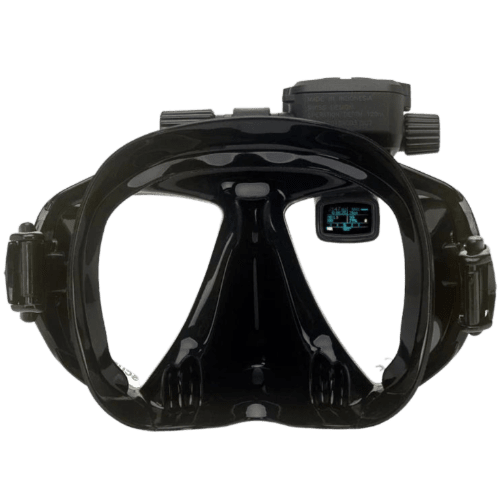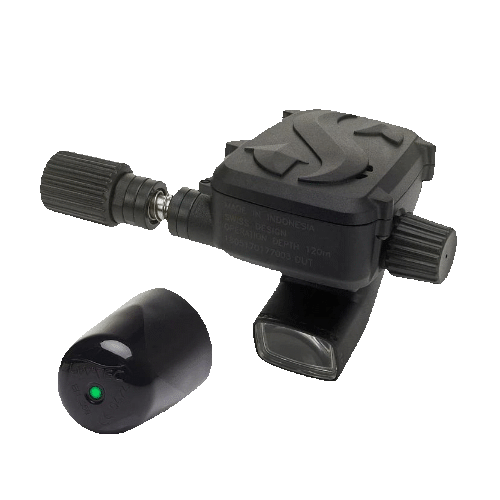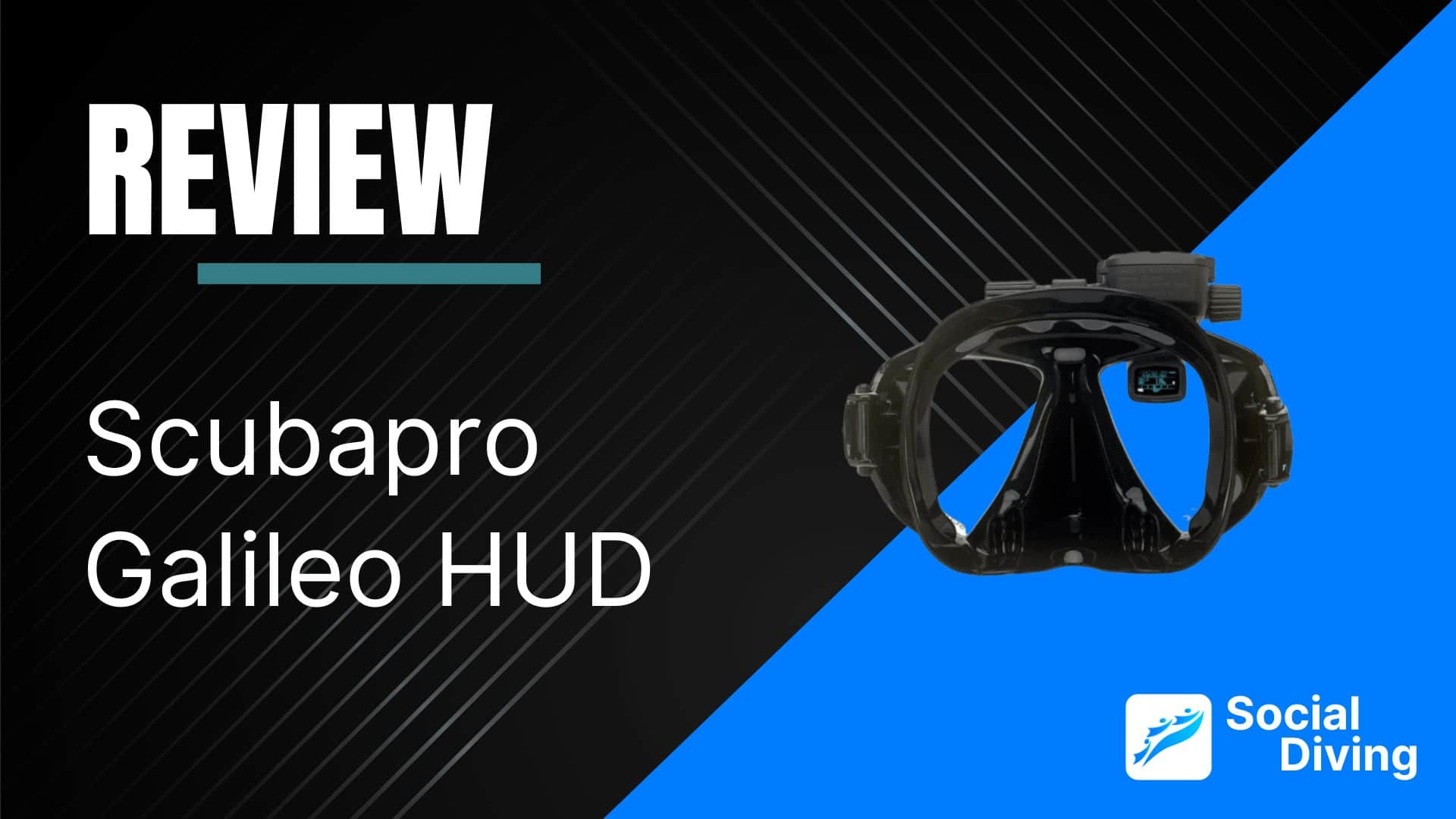The ScubaPro Galileo HUD stands out among the crowd as it is the only mask-mounted no-hands dive computer in the market. But does it live up to the hype?

Sure, we now have dive computers that work like smartwatches (or vice versa) but still, the basic working principles of a dive computer have not changed for decades: Wear it around your wrist or attached to the tank and look at it on a display.
The Galileo HUD challenges this approach and gives us a glimpse of what the future of dive computers may look like. It's also amazing for disabled divers!
Of course, we also read other opinions online but in the end, nothing beats real world experience. So we took the time for a thorough ScubaPro Galileo HUD test and review! Below you find everything you need to know, including features, specs and what we like, and don't like about it.
Review Summary
A unique concept for a hands-free diving experience with some flaws.
Our Rating
What We Like
- Mask mounted & hands free!
- Unique concept
- Air integration
- Great for disabled divers!
- Multigas capability with up to 8 gases
- 3D compass
- Rechargeable battery with up to 20 hours of dive time
- Bluetooth connectivity
- Full-color OLED display with adjustable brightness
- Bühlmann ZHL-16 ADT MB algorithm
Reasons to Avoid
- Many quality issues in the beginning
- Display can be distracting
- High price
- Requires special mount on mask
What could be improved
- Bring out a new version that is more stable!
Get it here
First Impression
In a hurry and looking for the gist of things? Here is our review in short. Keep reading for the entire version.
The ScubaPro Galileo HUD stands out among the crowd as it is the only mask-mounted no-hands dive computer in the market. This makes it great for underwater photographers, tech divers, and divers with disabilities!
The computer attaches to your dive mask, positioning a miniature full-color OLED screen in the diver’s line of sight. The display projects an image that appears at a virtual distance of about 1 meter, which means you can keep looking around while checking your data. Navigation is managed through a push-wheel on the device, which can be operated with ease, even when wearing thick gloves.
We like the display, the full-tilt compass is absolutely brilliant, and the concept itself is super innovative. Drawbacks are the high price, aforementioned quality issues, and the fact that it requires a special mount on your mask to use it.
If you love innovative products and need your hands free underwater, the ScubaPro Galileo HUD is your dive computer. If you can forgive some minor issues and are patient with customer support, you will receive a great piece of tech!
Please note that due to the mask-mounted approach, we are not able to provide as many in-action photos as we usually do. It’s pretty hard to get an accurate image of the heads up display, for example, that isn’t distorted when taking of the mask underwater.
About ScubaPro Dive Computers
ScubaPro as a scuba gear manufacturer needs no introduction. They are a market leader in many categories and have been for years. With one notable exception: Dive computers.
We think this is peculiar as other brands like Aqualung and Mares have successful models on the market despite being mainstream manufacturers.
The ScubaPro Galileo line includes the Galileo 3 and the Galileo HUD dive computer. One is a wristwatch while the other is the mask-mounted option we’re reviewing here.
The HUD was hailed as the biggest innovation since Nitrox before quickly falling a bit into oblivion among the scuba community. Not deserved, as we think. It does a lot of things right, it just suffers terribly from quality inconsistencies.
Build Quality
Let us be very direct: The build quality of the Galileo is only so-so. While we think ScubaPro’s Hydros Pro BCD or the Go Sport fins are amazing(!) this dive computer feels only half finished. It is small enough for the mask mount but doesn’t feel like it will survive dropping it on the ground a few more times than necessary.
For example, I love cave diving and this sometimes means that I need to get through very narrow passages. I haven’t tried it in this scenario but I am 100% sure that if I bump my helmet against something, the Galileo HUD will either come off or I won’t be able to see it.
We think the display feature itself is cool and works amazingly well – the same goes for the superb compass – but we are not sold on the quality yet. This is also in line with what others experience and ScubaPro should definitely fix the quality issues in version 2.
Our rating: 2 / 5
Design
The Galileo HUD dive computer attaches directly to your scuba mask, positioning a miniature full-color OLED screen in the diver’s line of sight. The display projects an image that appears at a virtual distance of about 1 meter, allowing divers to keep their eyes on their surroundings while monitoring vital data.
For obvious reasons, there are two parts to this: The physical computer and the projected display.
The former is nothing to brag about but also doesn’t bother anyone. The display, on the other hand, is really cool! It’s got all the necessary info right there and when navigating, the compass is really handy! Hands-free, baby!

The information is displayed in a non-intrusive manner, allowing for a natural viewing experience.
Our rating: 4/5
Ease of Use
Navigation is managed through a push-wheel on the device, which can be operated with ease, even when wearing thick gloves. The interface is designed to be intuitive and we think it is. Of course, there are some who will simply not like it, but in terms of ease of use, we have nothing to complain about.
The HUD’s display is always in your line of sight, allowing for constant monitoring of dive parameters without the need to look away or adjust position. We think this works absolutely fantastic and would love more brands to adopt this principle! During our tests underwater, the Galileo HUD’s display was crisp and easily legible in various conditions, from the bright surface waters and even when diving in murky quarries in Germany.
If you don’t want to look at the display, you simply flip it up and it’s gone. It’s that simple, really!
Our rating: 5/5
Features & Performance
The Galileo HUD is feature-packed:
- Air integration with an optional transmitter for monitoring gas levels
- Multigas capability, supporting up to eight gases, including nitrox and trimix
- 3D compass for precise navigation
- Rechargeable battery with up to 20 hours of dive time
- Bluetooth connectivity for dive data management
- Predictive Multi-Gas ZHL-16 ADT MB algorithm for accurate decompression calculations
It reads like a wishlist for your next dive computer.
The air integration feature provided real-time tank pressure readings, and switching between gases was straightforward. The built-in 3D compass was responsive and accurate, which enhanced navigation during the dive.
Apps & Connectivity
Equipped with Bluetooth, the Scubapro Galileo HUD dive computer can transfer and log your dives directly to your smartphone or tablet using the ScubaPro LogTRAK app. The app itself is robust, offering detailed analysis and sharing of dive data, enhancing the post-dive experience.
HOWEVER, it simply doesn’t work with the new Mac models. 😤 iPhones, Android, Windows, no issues here…but since we love our Macs, this was a big big issue. Especially since many underwater photographers and divers use Macs, we think this is a big no-go for many but might not affect you much.
Our rating: 2 / 5
Battery Life & Charging
Let’s start with this: If and when the battery works, it’s really good. As long as you keep it charged and not let it die, the computer will do its job just fine. The manual is also very vague about whether the computer needs to be fully charged before turning on or not.
However, we heard some horror stories of other who let theirs go into sleep mode…and it never came back from it. Of course, Scubapro’s support is great, but this should really be fixed asap!
Our rating: 3/ 5
Diving with the ScubaPro Galileo HUD
ScubaPro Galileo HUD for recreational diving
Interestingly enough, while the Galileo HUD is clearly laid out for recreational diving, it is a bit too pricey and advanced for casual divers. We think especially underwater photographers can benefit from the hands-free approach!
Another great use case is if you are a diver with disabilities. We have trained with many people who love to dive but find it hard to lift their arms or need their attention on other instruments. Having the data right in front of their eyes is a game changer!
ScubaPro Galileo HUD for technical diving
As explained above, the hands-free approach works great and the different algorithms and staging gas options are perfect for technical diving. Deco diving was fine with the Galileo HUD and it did its job. We especially liked it during stage handling as you can clip the tanks while still having all your decompression info on the screen.
As I said before, we haven’t yet dared to take it on a narrow cave dive for fear that it might come loose when hitting a rock.
Small tip: When used in Gauge Mode, it of course shows the average depth, current depth, and actual time, and unlike others also seconds instead of just minutes.
ScubaPro Galileo HUD for dive professionals and instructors
We think the ScubaPro Galileo HUD is in a really interesting spot here. Dive instructors often need to have their hands free and this is exactly what this dive computer allows them to do. As such, we would even go as far as to say that it is an optimal solution here…granted ScubaPro can fix its quality issues.
Air Integration
The Galileo HUD supports wireless air integration (AI), so you can monitor tank pressure and remaining air time directly on the display. This works great and we like how it is laid out.
There is not much to it and the integration is seamless. Way better than many others we’ve tried before.
ScubaPro Galileo HUD Decompression Algorithm
The Scubapro Galileo HUD dive computer uses two algorithms: A multigas algorithm Bühlmann ZH-L16 ADT MB PMG with PDIS (profile-dependent intermediate stops) and a Bühlmann ZH-L16 GF. We really like this choice as it is known for its accuracy and reliability in calculating decompression schedules.
It’s a bit on the conservative side but tech divers will like the inclusion of gradient factors!
The ScubaPro’s predictive multi-gas ZHL-16 ADT MB algorithm is an advanced decompression model used in their dive computers, including the Galileo HUD. This algorithm is based on the ZHL-16 model developed by Dr. Albert A. Bühlmann, renowned for its accuracy in predicting nitrogen and helium tissue absorption and release during a dive.
The “ADT MB” part represents Adaptive Decompression and Microbubble levels, which add an additional layer of safety. This allows the algorithm to adapt to your specific exposure to decompression stress and manage the formation of microbubbles. It’s designed to handle multiple gas mixes, and combined with different gradient factors this is perfect for technical diving and recreational diving alike.
This predictive capability, combined with its conservative approach, aims to reduce the diver’s risk of Decompression Sickness (DCS) by customizing decompression stops based on the dive profile and the diver’s behavior during the dive.
Conclusion
Sigh…this is tough.
We think thee ScubaPro Galileo HUD is a groundbreaking dive computer that stands out for its innovative design and extensive feature set. We love the unique HUD interface and the wide array of advanced diving features combined with the hands-free experience. It’s also very easy to use. Quality issues and the clear fact that it is a Gen 1 product prevent it from scoring higher.
If you have the money, the Galileo HUD is definitely worth it!
If you have any other questions or need advice, leave us a comment below and get the conversation started.
Join the email list to get regular diving, travel, and outdoor tips, tricks, news and our latest deals straight to your inbox!
Where to Buy



